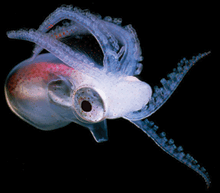 I tried a modification of a periplasmic protein prep to try and purify uptake DNA, which didn't work. There are several possible reasons why the experiment might not have worked, but one simple reason could be that I failed to dissociate DNA from the membranes and cells when I did the chloroform extraction.
I tried a modification of a periplasmic protein prep to try and purify uptake DNA, which didn't work. There are several possible reasons why the experiment might not have worked, but one simple reason could be that I failed to dissociate DNA from the membranes and cells when I did the chloroform extraction.I know! Maybe I should try an extraction that has already been used for purifying uptake DNA...
Kahn, Barany, and Smith (1983) PNAS 80:6927. Rather than describe the paper at length here, I just want to show Table 1 and Figure 4b, which relate to my extraction plans:

The first two columns describe the extraction conditions (rows 1-5). Competent cell cultures were incubated with a radiolabeled plasmid and pelleted after DNA uptake (5 or 60 min). Cell pellets were then resuspended in the indicated aqueous and organic solutions (columns A and B) in a 1:1 mixture, gently mixed, centrifuged to separate the phases, and radioactive counts in each fraction were measured.
The remaining columns indicate the relative amount of uptake in the different fractions and the identity of the radiolabeled DNA, either transformed into the chromosome (C) or still a double-stranded donor DNA molecule (D).
In the fourth condition (row 4), the aqueous phase consists of mostly donor DNA! So chromosomal contamination is in the pellet, and the desired donor molecules are in the aqueous phase. Sounds like a scheme. That’s what I’ll proceed with tomorrow.
Why not condition 1, just TE and phenol? Looks good, right? Because of Figure 4B:

The bottom line is that the phenol condition degraded the donor molecules (lane D), whereas the phenol/acetone condition did not (lane I). Here’s the gory details:
Lanes A-D describe phenol extraction of intact donor DNA molecules (Table 1, row 1):
A: input plasmid donor molecule.
B: total DNA from cells 4 min into uptake.
C: DNA extracted and dialyzed out of the pellet.
D: DNA extracted into the aqueous layer (TE).
Lanes E-J describe the phenol/acetone extraction of intact donor DNA molecules:
E: input again.
F: input cut with HindIII.
G: total DNA after 8 min uptake.
H: same as G, but digested with HindIII.
I: phenol/acetone extracted DNA after 8 mins.
J: same as I, but digested with HindIII.
The point of the HindIII digestion was as an additional test for whether molecules were donor or chromosomal. Chromosomal DNA is resistant to HindIII (this being Haemophilus influenzae after all), while donor DNA is not. Also, the HindIII digests show that the recovered DNA is double-stranded, since ssDNA won’t get cut.
Condition 4 it is, then:
Aqueous: TE/1.5 M CsCl
Organic: phenol/acetone, 1:1
That's what I'll try next.
Hmm, I’ll have to remember how to clean the DNA of CsCl after the extraction...I seem to remember doing something in particular at one point...

No comments:
Post a Comment